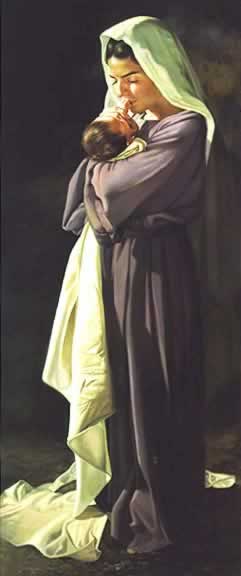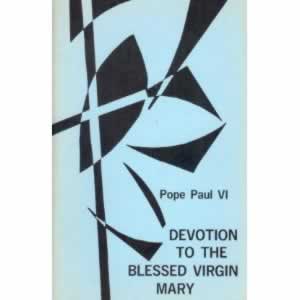Mary for Today – Part 4
Compromise at Vatican II
From Mediatrix to Model:
No text could be written to satisfy both sides in Vatican II. The group that saw Mary in parallel with Christ (as type of Christ) continued to urge the definition of Mary as mediatrix or at least as mother of the church. The very title of the chapter on Mary shows the compromise attempted: ‘The Role of the Blessed Virgin Mary, Mother of God, in the Mystery of Christ and the Church.’ The Constitution on the Church opens with the ringing words, “Christ is the light of all nations”; the church helps shed this light by proclaiming the gospel to every creature. Mary is a pre-eminent member of the church and faith-filled mother of Jesus Christ, once a pilgrim on earth herself and now with God in glory.
The Marian chapter returns to biblical and early Christian sources to sketch out Mary’s significance in relation to Christ and the church. Various gospel texts emphasise her motherhood, by which the Redeemer entered the world, and her faith, which led her to respond creatively to the call of God. The dynamism of her life lay in the way she grew in her pilgrimage of faith from the annunciation to the upper room at Pentecost. Her pilgrimage led her into the glory of God. The reality of Mary’s life is intertwined with the great events of saving history.
Mary in relation to Christ and Community: 
But the text often uses the term “nevertheless”: Mary’s unique role in salvation as mother of the Redeemer gives her a special relationship to the Trinity (as type of Christ), “at the same time, however, because she belongs to the offspring of Adam, she is one with all human beings in their need for salvation” (as type of church and humanity) #53 LG. United with her Son in the work of salvation from his birth to her presence at his side in heaven (type of Christ), she nevertheless did not understand his reply when she found him in the temple but pondered it in her heart (as type of church and humanity) #57.
Besides relating Mary to Christ, the chapter also positions Mary as a member of the church. The mediatrix issue kept touching a raw nerve and a carefully worded statement was included: “the Blessed Virgin is invoked in the Church under the titles of Advocate, Auxiliatrix, Adjutrix, and Mediatrix. These however are to be so understood that they neither take away from nor add anything to the dignity and efficacy of Christ the one Mediator. For no creature could ever be classed with the Incarnate Word and Redeemer” #62. The title is now one of several, in a context of piety rather than doctrine, and describing practice rather than prescription. In place of Mary as mediatrix, the council reached back to early Christian theology to emphasise Mary as a model of the church. St. Ambrose taught that ‘the mother of God is a model of the Church in the matter of faith, charity, and perfect union with Christ’ #63. As a model, she signifies the church called to its spiritual best.
Limitations within the Chapter:
The chapter is a long way from being satisfactory. Unlike the most significant chapter documents, it fails to place Marian theology in dialogue with the modern world. It fails to clarify what belongs to the Holy Spirit rather than Mary, an absence that causes functions of the Holy Spirit to be attributed to Mary’s maternal mediation. Nor was any connection established between Mary and women, Mary and the poor. But we need to remember that in this chapter more is said about Mary than by any council in history; it set a new but old direction for development. By placing her within the doctrine on the church, Mary was reconnected to the whole communion of saints living and dead.
Reform, Renewal, not Rejection: 
After the council, interest in things Marian rapidly diminished in industrialised countries. Theology became occupied with questions of Christ and faith in God along with the social and moral issues arising in the modern world. The council had intended that devotions be reformed, not that they be eliminated. But disappear they did, despite the heroic efforts of Paul VI in Marialis Cultus. Certain pious practices that not long ago seemed suitable were now being rejected. He does not promote these devotions because they are linked with the social and cultural patterns of a past age, showing the ‘ravages of time’. Paul called on the whole church to act creatively to renew these forms in accord with contemporary sensibilities, as respectful of sound tradition and open to the legitimate desires of today’s people (#24 MC). To do this, four guidelines were set in place to renew devotion in a creatively faithful way: it is in these four papal guidelines that we can see the fault line between the two millennia. From the principles of singularity, analogy, eminence, and suitability (basic to the second millennium) we leap to biblical, liturgical, ecumenical, and anthropological.
Biblical:
Biblical does not just mean skilful use of certain texts but steeping devotion to Mary in the great themes of the Christian message of salvation. Liturgical calls for practices of piety that should flow from and lead back to the Eucharist and harmonise with the liturgical seasons, notably Advent and Christmas. Ecumenical implies that honouring Mary should be based in sound scripture and clearly centring on Mary’s relationship with Christ, avoiding any exaggeration that would mislead other Christians about the true doctrine of the Catholic Church (#62).
That renewed devotion to Mary should be anthropological points to attuning to the human sciences that chart the changed psychological and sociological conditions in which people live today, and most notably, women. Pope Paul pointed out that women feel alienated from Mary because traditional piety presents her as a ‘timidly submissive woman or one whose piety was repellent to others, a picture formed by previous generations who drew on their own cultural norms regarding women. The church ‘does not bind herself to any particular expression of an individual cultural epoch or to the particular anthropological ideas underlying such expressions’ (#36). The task of our times is to employ our own awareness, name the problems honestly, and offer an attractive presentation suitable to this age.
Karl Rahner gave a perceptive insight that the image of Mary in the church has always been closely tied to the image of women at any given time. Since the culturally conditioned image of women in our day is undergoing radical change, this raises important questions if we are to have an image of Mary for our times and our Church.
Source: Johnson, Elizabeth A. (2004) Truly Our Sister. Continuum: New York. Ch.6.
Next: Mary, her life in her world.


 Entries(RSS)
Entries(RSS)